EDUQUAS BIOLOGY: Nutrition and adaptations of the gut
1/49
There's no tags or description
Looks like no tags are added yet.
Name | Mastery | Learn | Test | Matching | Spaced |
|---|
No study sessions yet.
50 Terms
Autotrophic nutrition
Organisms which can make their own food from simple inorganic materials.
They are producers e.g Plants
The prefix ‘Auto’ means self and “trophic” means feeding ,so it literally means self feeding.
Heterotrophic nutrition
Organisms which cannot make their own food and instead consume complex organic molecules from producers.
They are consumers of autotrophs.
The prefix ‘Hetero’ means different and “trophic” means feeding ,so it literally means different feeding.
What do vectors do?
Vectors transmit parasites from one host to another.
e.g A mosquito transferring malaria through pricking skin/ biting.
How have Tapeworms adapted?
1) They have hooks and suckers at the Scolex which allows it to cling to the Duodenum wall.
2) It is able to make enzyme inhibitors which prevents the host’s enzymes from digesting it.
3) It has a thick body which covers the cuticle and protects it from the hosts immune responses.
What is symbiotic and mutualistic nutrition?
When an organisms relationship benefits each other.
What is an Obligate parasite?
Cannot complete its life cycle without exploiting a host.
How have Lice adapted?
1) Lice have antennae that help them orient themselves
2) They have short legs with large claws and opposing thumbs that grip to their hosts hair.
What are Saprotrophic organisms?
Saprotrophs feed on dead decaying matter
This type of nutrition is used by all fungi and some bacteria
They don’t have a specialised digestive system and they undergo extra cellular digestion by the secretion of enzymes on to food material outside the body.
They absorb the soluble products of digestion across there cell membranes by diffusion and AT.
What are decomposers?
They are microscopic saprotrophs
They decay leaf litter and recycle nutrients such as Nitrogen.
Why does bread decompose?
Fungi forms (moulds) and enzymes are secreted.
The starch in the bread will be broken down to form the disaccharide maltose.
What are Photoautotrophic organisms?
Use light at the energy source to perform photosynthesis.
A type of autotrophic nutrition.
This is Holophytic nutrition.
Some are protoctista and some are bacteria.
What are Chemoautotrophic organisms?
Organisms use energy from chemical reactions and are prokaryotes.
They perform chemosynthesis (less efficient than photosynthesis).
Used it prokaryotes (mostly Bacteria).
What are Ectoparasites?
Parasites which live on the external surface of hosts.
What is an example of an Ectoparasite?
Human Head lice
What are Endoparasites?
Parasites which live inside the body of a host.
What is an example of an Endoparasite?
A Pork Tapeworm.
What are adaptations of Hydra?
Tentacles which sting and paralyse prey.
Tentacles secrete digestive enzymes.
What are the adaptations of Amoeba?
They have pseudopodia - fake legs.
They can take in large molecules by endocyotisis and digest using the Lysosomal enzymes and egest the waste products by exocytosis.
What is a Hermaphrodite?
Has Male and Female reproductive organs.
What are problems for the tapeworm?
Immune system responses.
pH of stomach acid.
Digestive enzymes in the stomach will try break it down.
A lack of nutrients which could mean a lack of reproduction
Peristalsis movements.
What are the 4 stages of digestion?
1) Ingestion
2) Digestion
3)Absorption
4) Egestion
How have Algae adapted to the mode of nutrition?
They have chloroplasts/ chlorophyll for photosynthesis.
What 2 stages of digestion do humans undergo in the Buccal cavity?
Mechanical and Chemical digestion
Which enzyme does the stomach produce?
Protease
Where is digestion of the food completed?
The small intestine.
Where does Carbohydrate digestion begin?
Mouth
Where does chemical digestion begin?
Mouth
What enzymes are present in intestinal juice?
Lipase
Maltose
Protease
Where does protein digestion begin?
The stomach
How does food move through your digestive system?
Muscle movements called peristalsis.
What kills bacteria in the human alimentary canal?
Gastric juice

What are the 4 layers of the gut?
Mucosa
Sub-Mucosa
Muscularsis
Serosa
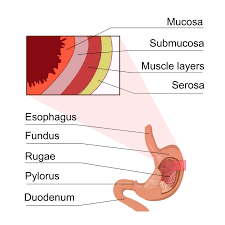
What is the mucosa?
The innermost layer which lines the gut wall
It’s epithelium secretes mucus which lubricates and protects it.
It secretes digestive
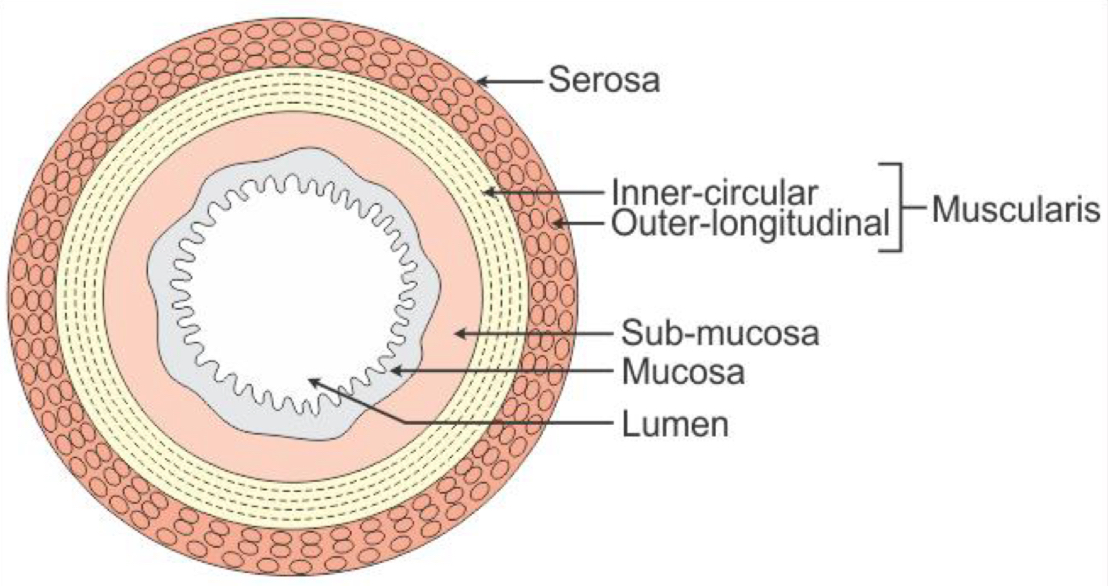
What is the submucosa?
Tissue which supports the Mucosa by its specialized function of nutrient, fluid, and electrolyte absorption.
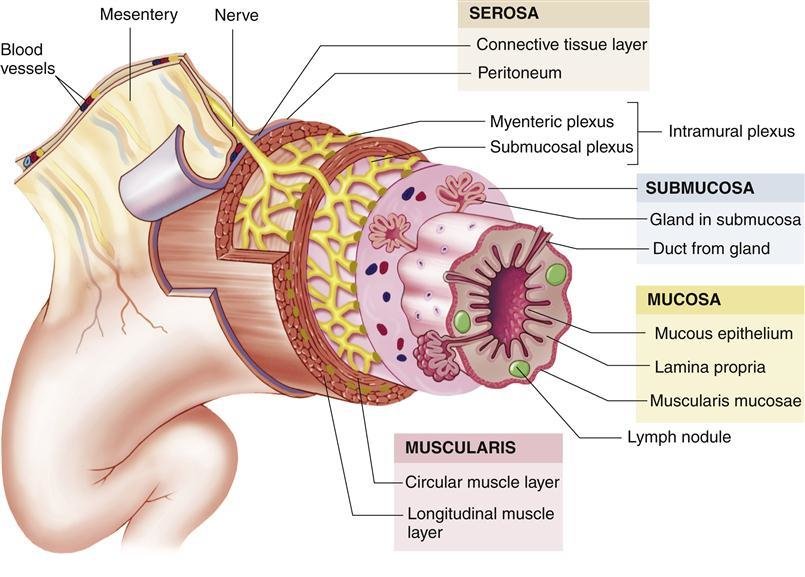
What is the muscularsis?
It’s responsible for the movement of food through the digestive tract via peristalsis.
It consists of two main layers of smooth muscle: an inner circular layer and an outer longitudinal layer.
These layers work together to produce rhythmic contractions (peristalsis) that propel food and chyme through the digestive tract.
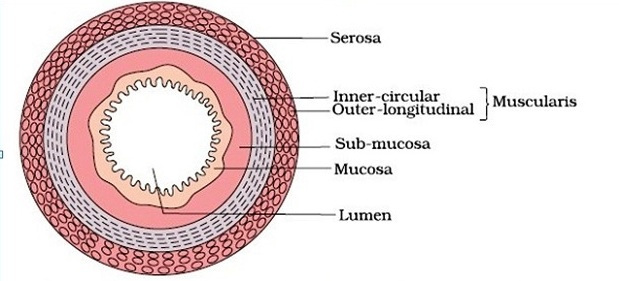
What are the roles of circular and longitudinal muscle in peristalsis?
-Circular muscles contract behind the bolus to prevent backflow and relax in front to allow passage.
-Longitudinal muscles contract to shorten the distance the bolus needs to travel and propel it forward.
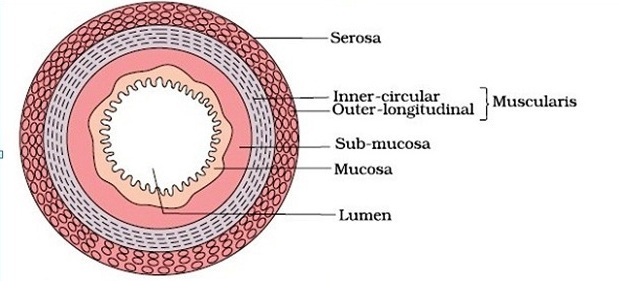
What is the structure and function of the serosa?
It’s the outermost layer of the gut wall and a smooth membrane that secretes serous fluid to reduce friction between the gut and surrounding organs, allowing for smooth movement during digestion
What happens to excess amino acids?
They are broken down in the liver
The amine group is removed and converted into urea (a less toxic substance) which is then excreted through urine.
How is glucose absorbed in the blood stream?
By Active transport
With co transport with sodium ions in a pump.
Where are the fatty acids and glycerol absorbed?
The lacteal.
What happens to water during absorption?
Most is absorbed in the ileum; Whatever’s left will have mineral salts which is absorbed by the colon.
How are the fatty acids and monoglycerides absorbed into the epithelial cells?
By simple diffusion.
How has the gut of the Hydra adapted?
Intracellular digestion by the cavity being lined with specialised cells which secrete digestive enzymes.
Tentacles lined with stinging cells to capture prey
How has the gut of the Rabbit adapted?
Rabbits have a large cecum (which is a specialised part of the large intestine) which houses a wide range of microorganisms and bacteria which break down fibre and plant material through fermentation.
Rabbits engage in a behaviour known as coprophagy where they eat there own nutrient dense faeces; This process is essential because rabbits need to extract as many nutrients as possible from their low-calorie, high-fibre diet.
How has the gut of a flatworm adapted?
In many species, the gut is incomplete, meaning it has only one opening, which serves as both the mouth and the anus.
he flat, ribbon-like shape of the flatworm increases the surface area to volume ratio, facilitating diffusion of nutrients and gases across the body and their shape reduces the distance cells are from the digestive cavity, making nutrient absorption and waste removal more efficient.
How has the gut of cows adapted?
They have a four-chambered stomach, which is critical for breaking down tough plant materials like grasses.
The cow’s stomach chambers, particularly the rumen, host a rich community of microbes that break down fibrous plant materials like cellulose.
How has the gut of Jellyfish adapted?
They have a gastrovascular cavity rather than a complex stomach or intestines. This cavity serves as both a digestive and circulatory space. It has a single opening that functions as both the mouth and the anus.
They primarily rely on extracellular digestion within the gastrovascular cavity. Enzymes are secreted into the cavity to break down the food into smaller, absorbable nutrients.
What is the alimentary canal?
A continuous pathway where food travels through the body, from ingestion to elimination.
Also known as the digestive tract or the gastrointestinal tract.
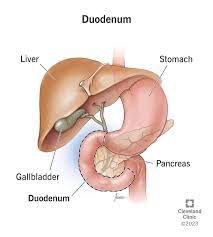
What is the structure and the function of the Duodenum?
A short, C-shaped segment that receives partially digested food from the stomach and plays a crucial role in digestion and nutrient absorption, mixing it with bile and pancreatic enzymes.
It’s the first part of the SMALL INTESTINE.
What are adaptations of the Duodenum?
The duodenum has Brunner's glands, which secrete mucus rich in sodium bicarbonate, helping to neutralise stomach acids.
The mucosa, the innermost layer, is lined with projections called villi, microvilli and circular folds which significantly increase the surface area for absorption.